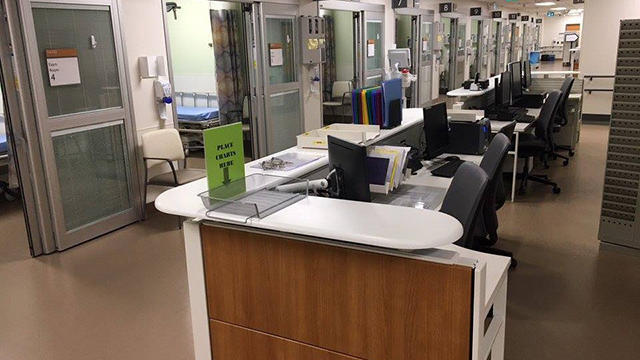Thousands of Patients Were Stuck on Hallway Stretchers at Brampton Civic This Year
Published October 31, 2017 at 11:57 pm

If you thought one woman stuck on a stretcher in a hallway at Brampton Civic for five day
If you thought one woman stuck on a stretcher in a hallway at Brampton Civic for five days was bad, it may or may not surprise you to learn that a dangerous amount of patients were in fact stuck on stretchers in Brampton Civic’s hallways when the hospital went into Code Gridlock earlier this year.
Overcrowding at Brampton Civic has continued to reach alarming rates this year, and now, a memo obtained by the NDP has revealed just how many patients stayed on stretchers in hospital corridors for often ludicrous lengths of time waiting for a hospital bed. How many, you ask?
A whopping 4,300 patients, often waiting anywhere from 40-70 hours for a bed, were stuck on stretchers in Brampton Civic’s hallways during the hospital’s Code Gridlock. Code Gridlock – basically meaning the hospital was overcrowded – was in effect for 65 days at Brampton Civic this year alone.
According to the Ontario NDP, that kind of overcrowing at Brampton Civic isn’t getting better – it’s getting much worse.
Ontario NDP leader Andrea Horwath had released a statement in September of this year saying that, in 2017, occupancy rates in acute care have been stuck at over 100 per cent and reaching as high as 109 per cent at Brampton Civic.
But that’s just the “tip of the iceberg” according to a recent release from the Ontario Health Coalition, the organization that has been “fighting hospital cuts and closures” for the past decade. According to the Ontario Health Coalition, Overcrowding is not just a Brampton problem, but an issue province-wide.
“Ontario hospitals in every medium-to-large sized town in Ontario report that they are full, often running at dangerous levels of overcrowding amounting to 100 percent capacity (every single bed full at all times) or even higher,” says the Ontario Health Coalition.
Any hospital across the globe that exceeds 85 per cent in capacity faces a number of issues as a result, so it’s worrisome that Ontario’s hospitals are going over capacity by 15 per cent.
Internationally – and unsurprisingly – a hospital that operates above 85 per cent patient capacity leads to “bottlenecks and blocked emergency departments, take ambulances off the road in offload delays, increase incidence of hospital-acquired infections, increase violence, and lead to inadequate care.”
And of course overcrowded emergency departments leads to higher rates of patient mortality.
Though it was recently announced that Brampton Civic is getting a few more beds, Ontario has the least number of hospital beds per capita in all of Canada. Further, hospitals in Ontario are often running at 100-120 per cent or higher capacity.
So, a few more beds might not cut it.
“The bottom line is this: Ontario’s hospital funding is among the very lowest in Canada, and, after decades of cuts we have the fewest hospital beds left in the developed world,” says Natalie Mehra, executive director of the Ontario Health Coalition. “We also have a severe shortage of long-term care beds.”
The number of funded beds at Brampton Civic Hospital is currently about half of the provincial average of 2.3 beds per 1,000 people. Current census data shows that the city boasts a population of 593,638 (a notable increase from the 523,906 it clocked in at in 2011). As of May 2017, there were only 608 beds available, though to support our population (and its constant growth), we would need well over 1,000.
According to the Ontario Health Coalition, the number of hospital beds – and staff and services and hospital funding over all – have been cut to crisis levels across Ontario.
“There is no evidence to support the contention that Ontario should have less cost per capita because it has higher population density,” says the Ontario Health Coalition.
But the province is working on it.
“Ontario is providing $140 million to make more hospital beds available and enhance home care services,” said the province in a recent statement.
The impact of the province’s investment remains to be seen.
insauga's Editorial Standards and Policies advertising





